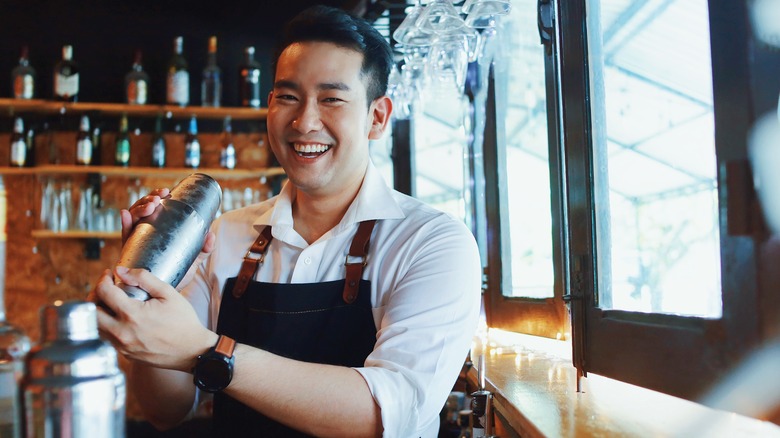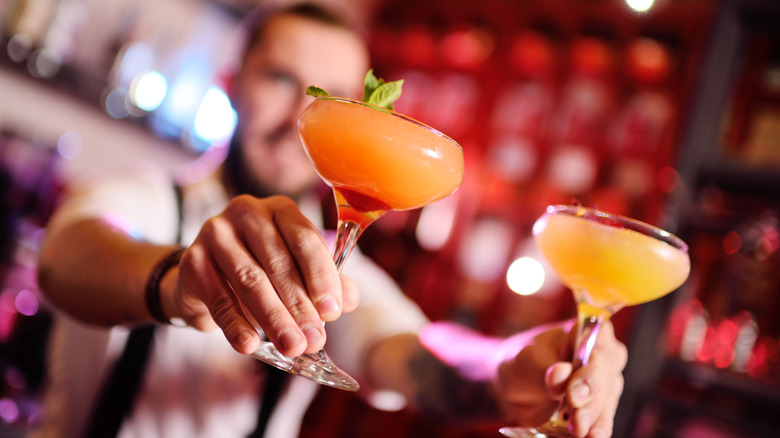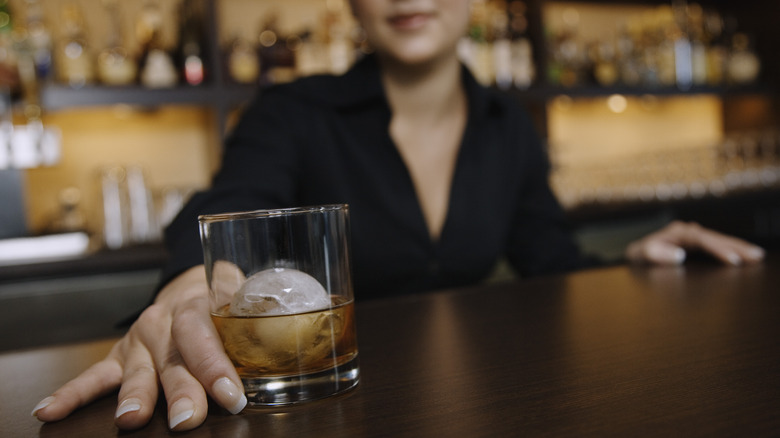How Bartenders Are Able To Make Drinks So Fast
"It takes a bartender about 30 seconds to pour a glass of wine, 45 seconds to pull a draft beer, and one minute to make a classic Martini," according to restaurant consultant Jerry Prendergast, and a specialty cocktail might take three times longer than a martini (via Forbes). Maybe even longer if you're delving into more complicated specialty cocktails like Bloody Mary, for which a simple, tried-and-true version requires no less than 10 ingredients.
But being in the service industry, many bartenders will go ahead and cheerfully make you that Commonwealth cocktail, notwithstanding that it's got more ingredients than there are seconds in a minute. Accordingly, to keep the drinks flowing bountifully to all, bartenders have to be fast on their feet and nimble with their fingers. So, then, kind of like Tom Cruise's hypersonic-handed cocktail craftsman in the critically-underrated-yet-still-a-hoot late-80s flick, "Cocktail," you might be thinking?
Well, not necessarily. Certainly, a flashy bartender with Cruise-like agility and reflexes could make for fast service. But, most of the time, making drinks fast would appear to require pretty much the opposite of flashy moves. Let's unpack that, shall we?
Fast bartending isn't frantic drink-making
Fast bartending isn't about juggling cocktail shakers. Rather, if pressed to describe "fast bartending" in a word, the word might well be "mindful." As New York City bartender Aly, who goes by RockStar BarGirl on social media, told her YouTube followers, "just because your movements are rapid doesn't mean that you are actually being a fast bartender." Or, putting it another way, moving rapidly without adequate organization, intent, and precision, amounts to frantic, not fast, bartending.
According to bar consultant and former nationally ranked fast-bartending champion Tess Anne Sawyer, "It's all about saving a few seconds here and there" (via Liquor). But the way you save seconds isn't by leaving, say, your Malibu bottle in the well — when you know that you and every other bartender on shift will be reaching for it on the back bar next time anyone's called upon to make a coquito. In other words, it might save a second or two at the moment, but it's virtually guaranteed to slow you and everyone else behind the bar down by a lot more. And that ultimately nets out to lost time.
In fact, the fastest bartenders are the most mindful — and they use some common tactics to get drinks out as quickly as possible. To sum it up, we've come up with a four-point outline that we hereby dub "SLOE." Spoiler alert: it's a mnemonic, and while it is SLOE like the gin, there's nothing slow about it.
Fast drinks demand SLOE bartending
Sloe gin isn't gin (it's a liqueur, per Settlers Spirits), and SLOE bartending isn't slow. To wit, the S in SLOE stands for "setting" up — the same way every time. This leverages muscle memory, and in a professional bar setting, that can quickly add up in terms of ripping through that growing thicket of tickets, per Liquor.
The L stands for "linking" drinks — by their common ingredients; if two of your drink orders call for, say, vodka, you can employ the double-jigger pouring method, which involves pouring one spirit into two jiggers at once, preferably with one hand, via Bartenders Business. It also means to the extent multiple drinks in one or more orders call for common ingredients (say, simple syrup or muddled mint), you can start building all of them at once, per Chilled Magazine. Although it might take a moment to organize and execute, it's a known time-saver.
The O in SLOE stands for "optimizing" every moment. When there's a lull, use it to refill your maraschino cherries, Aly suggests (via YouTube). Not having to stop to do so while constructing a whiskey sour can keep you from scurrying around in the pantry while you should be pouring. Finally, E stands for utilizing "efficiencies" of scale. That means not just wiping your station but rather the whole counter while you're at it. Likewise, why just crack an egg for every frothy fizz or sour? Instead, consider batching egg whites.


